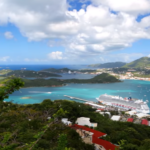As a Yank, I find myself drawn to explore beyond the continental borders of the United States with one such destination being the enchanting island of Saipan. Tucked away in the Pacific, this island gem forms a part of the Northern Mariana Islands (NMI) archipelago.
I’m going to take you on a journey, looking into whether US citizens, like myself, can pack up and relocate to this Pacific paradise. So buckle up and let’s delve into the ins and outs of moving to Saipan.
Saipan and Its Status

Located in the western Pacific Ocean, Saipan is the largest of the Northern Mariana Islands, a U.S. commonwealth. This tiny tropical retreat is situated approximately halfway between Japan and New Guinea, making it a rather strategic location.
The political status of Saipan is a unique one. It’s part of the Northern Mariana Islands, which has been a commonwealth in political union with the United States since 1975. What this means is that, while self-governing, the U.S. provides defense, funding, and social services. As a result, the islands, including Saipan, have a very interesting relationship with the United States.
They are not fully incorporated U.S. territories, like Puerto Rico, but instead operate under a Covenant that allows them to retain some control over their internal affairs while benefiting from U.S. protection and assistance. With this relationship in mind, we might assume that moving there from the U.S. would be a breeze, but let’s investigate further.
Visa Waiver Program (VWP)
While the Visa Waiver Program (VWP) is an important consideration for many international travelers, for US citizens, it’s somewhat irrelevant when contemplating a move to Saipan.
The VWP allows citizens of participating countries to travel to the United States without a visa for stays of 90 days or less. However, as Saipan is part of a U.S. commonwealth, American citizens are not required to have a visa to visit or move there.
Long-Term Residency

Given the unique political relationship between the U.S. and the Northern Mariana Islands, Americans have the right to reside in Saipan without any special immigration procedures or residency permits.
Simply put, if you’re an American citizen, you can move to Saipan as easily as you could move to any state within the U.S. There’s no need to worry about obtaining long-term visas or work permits.
However, while there may not be any legal barriers, there are practical considerations to take into account, such as finding employment and housing, which we’ll explore in upcoming sections.
Employment and Work Permits
Seeking employment is a pivotal aspect of any move, and Saipan is no different. U.S. citizens can indeed work in Saipan without needing a work permit or visa, a great advantage in making the transition smoother. However, it’s important to consider the job market on the island.
With a small population and a heavy reliance on tourism and service industries, employment opportunities in Saipan can be limited. Professions in high demand tend to be in education, healthcare, and the federal government, so those with skills in these sectors may find more opportunities. The key here is doing a thorough research and possibly securing a job before making the move.
Investing and Business Opportunities

For those entrepreneurial souls, Saipan could be the blank canvas you’re seeking. The island offers several business opportunities, especially in the tourism, agricultural, and fishing sectors. It’s entirely possible for a U.S. citizen to start a business in Saipan, and the process of doing so is not drastically different from that on the mainland.
To start a business, you would need to comply with local licensing and registration regulations, which would involve filing the necessary paperwork with the Registrar of Corporations and the Department of Finance’s Revenue and Taxation Office.
One encouraging factor for foreign investors is the CNMI’s Qualifying Certificate program, which offers tax breaks and incentives to promote economic growth. This is an avenue worth exploring for potential business owners considering making the move.
Education and Healthcare for US Citizens
For families and individuals considering the move, access to quality education and healthcare is a priority. Saipan’s education system falls under the administration of the Public School System of the CNMI. It comprises primary and secondary schools, and even a community college, the Northern Marianas College.
U.S. citizens moving to Saipan will have access to these educational institutions for their children. But it’s worth noting that some families opt for private or homeschooling options for a more diverse curriculum.
In terms of healthcare, Saipan is home to the Commonwealth Health Center, the primary hospital serving the Northern Mariana Islands. Additionally, numerous private clinics provide medical and dental services.
While the healthcare facilities are adequate for routine health issues and minor emergencies, for serious health conditions requiring specialized care, patients often travel off-island, usually to Guam or the U.S mainland. Health insurance is another factor to consider as it’s vital to understand what will be covered on-island and off-island.
Cost of Living and Lifestyle

Saipan provides a unique blend of Pacific island living with American influences. This beautiful island offers stunning natural beauty, warm tropical climate, and a slower-paced lifestyle, a stark contrast to the hustle and bustle of the U.S. mainland.
The cost of living is generally more affordable than major cities in the U.S. Housing, in particular, tends to be much cheaper, and so does fresh local produce. However, keep in mind that many goods are imported, which can increase the cost of certain items, including some groceries, household goods, and fuel. All in all, the cost of living will heavily depend on your lifestyle and the choices you make.
Legal and Tax Considerations
Moving to Saipan doesn’t just involve packing your bags; there are also legal and tax considerations to keep in mind. While Saipan operates under U.S. law, there are local laws and regulations that residents must abide by. Therefore, it’s a good idea to familiarize yourself with these local rules, which may differ somewhat from those on the mainland.
As for taxes, U.S. citizens in Saipan do have tax obligations. While federal income taxes are not directly imposed, the CNMI government administers its own tax system based on U.S. Internal Revenue Code. The collected taxes fund the local government’s operations.
It’s worth noting, however, that the specifics of tax liability can be complex and may depend on factors such as sources of income and length of residence. Therefore, consulting with a tax professional or advisor familiar with Saipan’s tax laws would be prudent.
Fun Facts
- Saipan is home to the Flame Tree, the national tree, which blooms vibrant red flowers every April.
- The Grotto, a popular diving spot in Saipan, is considered one of the best cavern dives in the world.
- Saipan was the site of the Battle of Saipan during World War II, and remnants of the war, like tanks and artillery, are still visible today.
- The island is home to several species of unique wildlife, such as the Mariana fruit bat and the Micronesian Megapode, a bird that uses volcanic heat to incubate its eggs.
- With a population of just over 50,000, Saipan maintains a small-town feel despite its status as the CNMI’s largest island.
FAQ
Can I Drive with A U.S. License in Saipan?
U.S. driver’s licenses are valid in Saipan.
Are There Direct Flights from The U.S. to Saipan?
Currently, there are no direct flights from the U.S. mainland to Saipan. Most flights connect through Asian cities like Tokyo or Manila.
Can I Use U.S. Dollars in Saipan?
Yes, as a U.S. commonwealth, the official currency in Saipan is the U.S. dollar.
Is English Spoken in Saipan?
English and Chamorro are the official languages.
Are Pets Allowed to Be Brought to Saipan?
Yes, but pets need to comply with the CNMI’s quarantine requirements.
Conclusion
Packing up and moving to Saipan? It’s indeed a possibility for U.S. citizens, with no visa or immigration hurdles to overcome.
The island offers a unique blend of American and Pacific Islander cultures, nestled in an idyllic tropical setting. From finding employment, considering investment opportunities, to navigating the cost of living and understanding tax obligations, there’s a lot to consider.
Whether Saipan ends up being your dream destination or just another place on your bucket list, it’s an island that presents an exciting option for U.S. citizens looking for a new adventure.
Discover the ideal destinations to relax and rejuvenate in the Northern Mariana Islands, where luxury meets serenity.






